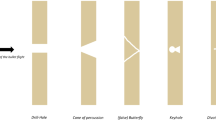Abstract
In cases of terrorist bomb attacks, the issue of victim identification is the principal aim. For investigators and justice, terrorists must also be identified in a timely manner. The fragmentation of bodies caused by explosive devices however makes this operation difficult. The cases presented correspond to six autopsies of perpetrators carrying explosives. Their explosive belts produced different body sections on areas correlated with the location on the body of carrying explosive charges. Indeed, cross-sectional areas are the signature of the level of explosive devices on the body, and some fracture features through the damage of certain areas of constitutional weaknesses are specific elements to consider. These elements can allow a quick distinction between victims and terrorists, in order to assist in the medico-legal process of identification.

Similar content being viewed by others
References
Giles J, Hopkin M (2005) Psychologists warn of more suicide attacks in the wake of London bombs. Nature 436:308–309
Carli P, Pons F, Levraut J, Millet B, Tourtier JP, Ludes B, Lafont A, Riou B (2017) The French emergency medical services after the Paris and Nice terrorist attacks: what have we learnt? Lancet. https://doi.org/10.1016/S0140-6736(17)31590-8
Quatrehomme G, Police d’Identification de Victimes de Catastrophes U, Toupenay S, Delabarde T, Padovani B, Alunni V (2018) Forensic answers to the 14th of July 2016 terrorist attack in Nice. Int J Legal Med. https://doi.org/10.1007/s00414-018-1833-5
Prieto JL, Tortosa C, Bedate A, Segura L, Abenza JM, Mariscal de Gante MC, Conejero J, Magaña C, Perea B (2007) The 11 March 2004 Madrid terrorist attacks: the importance of the mortuary organisation for identification of victims. A critical review. Int J Legal Med 121:517–522
Mundorff AZ, Black S, Blau S et al (2015) Disaster victim management – the role of the anthropologist. In: Payne James J, Byard R (eds) Encyclopedia of forensic and legal medicine, 2nd edn. Elsevier, London, pp 288–304
Sweet D (2010) INTERPOL DVI best-practice standards - an overview. Forensic Sci Int 201:18–21
Sudoyo H, Widodo PT, Suryadi H, Lie YS, Safari D, Widjajanto A, Kadarmo DA, Hidayat S, Marzuki S (2004) DNA analysis in perpetrator identification of terrorism-related disaster: suicide bombing of the Australian Embassy in Jakarta. Forensic Sci Int Genet 2:231–237
Montelius K, Lindblom B (2012) DNA analysis in disaster victim identification. Forensic Sci Med Pathol 8:140–147
Friedlander FG (1946) The diffraction of sound pulses I. diffraction by a semi-infinite plane. Proc R Soc Lond A 186:322–344
Ramasamy A, Hill AM, Masouros S, Gibb I, Bull AM, Clasper JC (2011) Blast-related fracture patterns: a forensic biomechanical approach. J R Soc Interface 8:689–698
Rozenfeld M, Givon A, Shenhar G, Renert L, Peleg K (2016) A new paradigm of injuries from terrorist explosions as a function of explosion setting type. Ann Surg 263:1228–1234
Aggrawal A, Tsokos M (2005) Terrorism: suicide bombing, investigation. In: Payne-James JJ, Byard RW, Corey TS, Henderson C (eds) Encyclopedia of forensic and legal medicine, 2nd edn. Elsevier Academic Press, London, pp 289–296
Wolf SJ, Bebarta VS, Bonnett CJ, Pons PT, Cantrill SV (2009) Blast injuries. Lancet 374:405–415
Mathews ZR, Koyfman A (2015) Blast injuries. J Emerg Med 49:573–587
Harrison SE, Kirkman E, Mahoney P (2007) Lessons learnt from explosive attacks. J R Army Med Corps 153:278–282
Dussault MC, Smith M, Osselton D (2014) Blast injury and the human skeleton: an important emerging aspect of conflict-related trauma. J Forensic Sci 59:606–612
Hiss J, Kahana T (1998) Suicide bombers in Israel. Am J Forensic Med Pathol 19:63–66
Coupland RM, Korver A (1991) Injuries from antipersonnel mines: the experience of the International Committee of the Red Cross. BMJ 303:1509–1512
Tsokos M, Türk EE, Madea B, Koops E, Longauer F, Szabo M, Huckenbeck W, Gabriel P, Barz J (2003) Pathologic features of suicidal deaths caused by explosives. Am J Forensic Med Pathol 24:55–63
Varga M, Csabai G (1992) A suicidal death by explosives. Int J Legal Med 105:35–37
Davis EB, Rollins CE, Reiber GD, Anthony RM (1999) Suicide by pipe bomb: a case report. Am J Forensic Med Pathol 20:136–140
Rajs J, Moberg B, Olsson JE (1987) Explosion-related deaths in Sweden—a forensic pathologic and criminalistic study. Forensic Sci Int 34:1–15
Samarasekera A (2008) Case Study 3.3:“Human Bomb” and Body Trauma. In: Kimmerle EH, Baraybar JP (eds) Skeletal trauma: identification of injuries resulting from human rAbuse and armed conflict. CRC Press, Bocca Raton, pp 128–149
Christensen AM, Smith VA, Ramos V, Shegogue C, Whitworth M (2012) Primary and secondary skeletal blast trauma. J Forensic Sci 57:6–11
Lees B, Molleson T, Arnett TR, Stevenson JC (1993) Differences in proximal femur bone density over two centuries. Lancet 341:673–676
Hull JB, Cooper GJ (1996) Pattern and mechanism of traumatic amputation by explosive blast. J Trauma 40:S198–S205
Acknowledgments
We would like to express our sincere appreciation to Céline Deguette, Charlotte Gorgiard, Isabelle Sec, and Lilia Hamza.
Author information
Authors and Affiliations
Corresponding author
Ethics declarations
Conflict of interest
The authors declare that they have no conflict of interest.
Rights and permissions
About this article
Cite this article
Delannoy, Y., Delabarde, T., Plu, I. et al. Terrorist explosive belt attacks: specific patterns of bone traumas. Int J Legal Med 133, 565–569 (2019). https://doi.org/10.1007/s00414-018-1977-3
Received:
Accepted:
Published:
Issue Date:
DOI: https://doi.org/10.1007/s00414-018-1977-3




